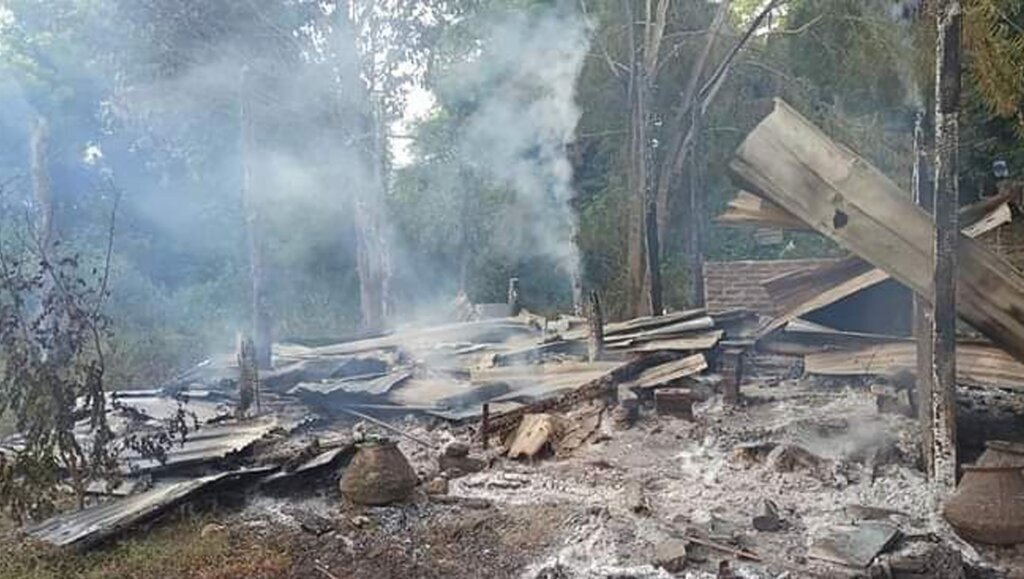Myanmar’s civil war has seen a devastating increase in attacks on schools, researchers say

BANGKOK (AP) — An intensification of fighting in Myanmar’s civil war has brought a sharp increase in destructive attacks on schools, a group that monitors armed conflict in the Southeast Asian nation said in a report Saturday.
Myanmar Witness said the attacks have further strained Myanmar’s already fractured school system, taking away education for millions of children who have also been forced to flee their homes, miss vaccinations and suffer from inadequate nutrition.
The group, a project of the United Kingdom-based Center for Information Resilience, identified a total of 174 attacks on Myanmar schools and universities since the military seized power from the elected government of Aung San Suu Kyi three years ago. It said the count came from evidence in social media and news reports.
Other groups have suggested higher numbers of attacks. The Global Coalition to Protect Education from Attack, an advocacy group based in New York, counted over 245 reports of attacks on schools and 190 reports of military use of educational facilities in 2022-23.
The 2021 military takeover was met with widespread nonviolent demonstrations for democracy, but those were crushed with lethal force. Many opponents of military rule then took up arms, and large parts of the country are now embroiled in conflict. The military government is estimated to control less than half the country.
“Education underpinned the democratic movement in Myanmar, but today Myanmar’s youth are witnessing their schools — and life opportunities — reduced to rubble,“ said Matt Lawrence, project director at Myanmar Witness. “If education is not protected throughout Myanmar, the next generation’s view of the world risks being driven by factionalism and war, rather than hope and reason.”
Student enrollment in Myanmar dropped 80% from the beginning of the COVID-19 pandemic in 2020 through 2022, a year after the army’s takeover, according to the humanitarian group Save the Children. By mid-2022, about half the country’s children, or 7.8 million, were not attending schools, it said.
Myanmar Witness said it documented reports of 64 fatalities and 106 injuries associated with the 176 attacks on schools, though most could not be verified.
Myanmar’s shadow National Unity Government, which leads the pro-democracy struggle against military rule, estimated in January that more than 570 children under age 18 had been killed in various circumstances by security forces. Upwards of 8,000 civilians have been killed in the conflict, according to the multinational Armed Conflict Location & Event Data Project.
Myanmar Witness put most of the responsibility for the destruction of schools on airstrikes conducted by the Myanmar military. Air attacks have become more frequent as pro-democracy forces and ethnic minority armed groups allied with them have made gains on the battlefield.
The military “has had to resort to more and more airstrikes, often with less and less appropriate aircraft, as they lose effective access to the ground” as a result of offensives by the resistance, Lawrence told The Associated Press.
The military government has consistently denied targeting civilians or using disproportionate force.
The report said resistance forces also have attacked schools, but much less frequently and less destructively, often using drones with small explosive loads.
Education is also being disrupted by other factors. Many young people, including older students, have taken a greater role in the resistance. Thousands of teachers left their jobs after the army seized power and joined a civil disobedience movement aimed at disabling military control over government institutions. And the conflict’s shifting front lines make it difficult for teachers to provide lessons on a reliable basis.
Some teachers have established or joined schools outside the reach of the military’s control.
“What we see is almost a dual system that’s developing in Myanmar, where there are state-sponsored schools and then schools sponsored by other parties and retribution for participating in either system,” said Lisa Chung Bender, executive director of the Global Coalition to Protect Education from Attack.
“It puts children and educators in an impossible position where they have to go through checkpoints and say where they’re going, and if it’s determined that they’re going to an enemy school, whichever enemy that is, they can be harassed, detained, or physically punished,” she said.
The lack of proper access to education is only part of a deepening humanitarian crisis in Myanmar. More than 3 million people have been displaced from their homes by fighting, most since the military’s seizure of power in 2021, and the country suffers from a deepening economic crisis.
A report in June by the United Nations Children’s Fund on global child food poverty said 35% of Myanmar’s children live in food poverty, defined as having access to half or fewer of the eight food groups children need daily for healthy growth and development.
According to the U.N. Development Program, over half of Myanmar’s children now live in poverty as the country’s nascent middle class has disappeared.
